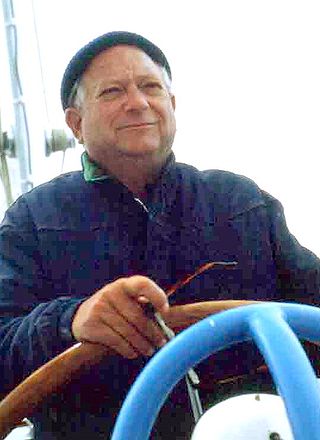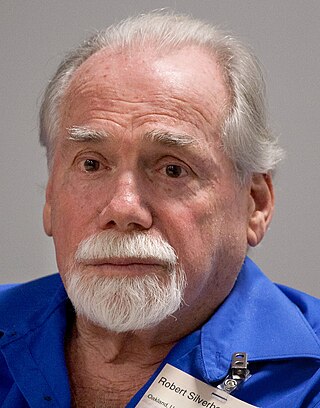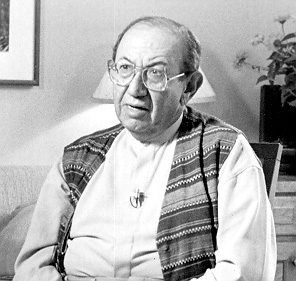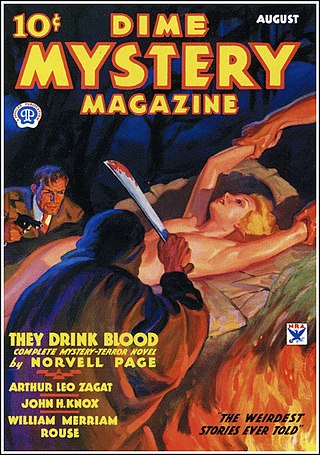Related Research Articles

Horror is a genre of fiction that is intended to disturb, frighten or scare. Horror is often divided into the sub-genres of psychological horror and supernatural horror, which are in the realm of speculative fiction. Literary historian J. A. Cuddon, in 1984, defined the horror story as "a piece of fiction in prose of variable length... which shocks, or even frightens the reader, or perhaps induces a feeling of repulsion or loathing". Horror intends to create an eerie and frightening atmosphere for the reader. Often the central menace of a work of horror fiction can be interpreted as a metaphor for larger fears of a society.

Michael John Moorcock is an English–American writer, particularly of science fiction and fantasy, who has published a number of well-received literary novels as well as comic thrillers, graphic novels and non-fiction. He has worked as an editor and is also a successful musician. He is best known for his novels about the character Elric of Melniboné, which were a seminal influence on the field of fantasy in the 1960s and 1970s.

John Holbrook Vance was an American mystery, fantasy, and science fiction writer. Though most of his work has been published under the name Jack Vance, he also wrote several mystery novels under pen names, including Ellery Queen.

A novella is a narrative prose fiction whose length is shorter than most novels, but longer than most short stories. The English word novella derives from the Italian novella meaning a short story related to true facts.
Genre fiction, also known as formula fiction or popular fiction, is a term used in the book-trade for fictional works written with the intent of fitting into a specific literary genre in order to appeal to readers and fans already familiar with that genre.

Robert Silverberg is an American author and editor, best known for writing science fiction. He is a multiple winner of both Hugo and Nebula Awards, a member of the Science Fiction and Fantasy Hall of Fame, and a Grand Master of SF. He has attended every Hugo Award ceremony since the inaugural event in 1953.
Night Watch or Nightwatch may refer to:

A romance novel or romantic novel generally refers to a type of genre fiction novel which places its primary focus on the relationship and romantic love between two people, and usually has an "emotionally satisfying and optimistic ending." Precursors include authors of literary fiction, such as Samuel Richardson, Jane Austen, and Charlotte Brontë.
Standard manuscript format is a formatting style for manuscripts of short stories, novels, poems and other literary works submitted by authors to publishers. Even with the advent of desktop publishing, making it possible for anyone to prepare text that appears professionally typeset, many publishers still require authors to submit manuscripts within their respective guidelines. Although there is no single set of guidelines, the "standard" format describes formatting that is considered to be generally acceptable.

Lambda Literary Awards, also known as the "Lammys", are awarded yearly by Lambda Literary to recognize the crucial role LGBTQ writers play in shaping the world. The Lammys celebrate the very best in LGBTQ literature. The awards were instituted in 1989.

Daniel Keyes was an American writer who wrote the novel Flowers for Algernon. Keyes was given the Author Emeritus honor by the Science Fiction and Fantasy Writers of America in 2000.

Jeffrey Ford is an American writer in the fantastic genre tradition, although his works have spanned genres including fantasy, science fiction and mystery. His work is characterized by a sweeping imaginative power, humor, literary allusion, and a fascination with tales told within tales. He is a graduate of Binghamton University, where he studied with the novelist John Gardner.
John Fenwick Anderson Blackburn was a British novelist who wrote thrillers, and horror novels. Blackburn was described as "today's Master of Horror" by The Times Literary Supplement.
Fiction writing is the composition of non-factual prose texts. Fictional writing often is produced as a story meant to entertain or convey an author's point of view. The result of this may be a short story, novel, novella, screenplay, or drama, which are all types of fictional writing styles. Different types of authors practice fictional writing, including novelists, playwrights, short story writers, radio dramatists and screenwriters.

Lee Goldberg is an American author, screenwriter, publisher and producer known for his bestselling novels Lost Hills and True Fiction and his work on a wide variety of TV crime series, including Diagnosis: Murder, A Nero Wolfe Mystery, Hunter, Spenser: For Hire, Martial Law, She-Wolf of London, SeaQuest, 1-800-Missing, The Glades and Monk.

Tales of Wonder was a British science fiction magazine published from 1937 to 1942, with Walter Gillings as editor. It was published by The World's Work, a subsidiary of William Heinemann, as part of a series of genre titles that included Tales of Mystery and Detection and Tales of the Uncanny. Gillings was able to attract some good material, despite the low payment rates he was able to offer; he also included many reprints from U.S. science fiction magazines. The magazine was apparently more successful than the other genre titles issued by The World's Work, since Tales of Wonder was the only one to publish more than a single issue.
Ted Kosmatka is an American writer. His short stories have been reprinted in ten Year's Best anthologies, and he is co-winner of the 2010 Asimov's Readers' Choice Award.[3] His 2012 novel The Games was nominated for a Locus Award for Best First Novel.
The following outline is provided as an overview of and topical guide to George R. R. Martin's A Song of Ice and Fire media franchise:

Dime Mystery Magazine was an American pulp magazine published from 1932 to 1950 by Popular Publications. Titled Dime Mystery Book Magazine during its first nine months, it contained ordinary mystery stories, including a full-length novel in each issue, but it was competing with Detective Novels Magazine and Detective Classics, two established magazines from a rival publisher, and failed to sell well. With the October 1933 issue the editorial policy changed, and it began publishing horror stories. Under the new policy, each story's protagonist had to struggle against something that appeared to be supernatural, but would eventually be revealed to have an everyday explanation. The new genre became known as "weird menace" fiction; the publisher, Harry Steeger, was inspired to create the new policy by the gory dramatizations he had seen at the Grand Guignol theater in Paris. Stories based on supernatural events were rare in Dime Mystery, but did occasionally appear.
References
- ↑ The Science Fiction and Fantasy Writers of America suggest 6 chars to a word
- ↑ Smiley, Jane. 2005. Thirteen Ways of Looking at the Novel. NY: Alfred A. Knopf, p. 14.
- ↑ Smiley, 2005, p. 15.
- ↑ Edge, Tom, "Does Size Matter?" The Guardian (UK), Booksblog, Nov. 2, 2006. http://www.guardian.co.uk/books/booksblog/2006/nov/02/doessizematter
- ↑ Quindlen, Anna (September 23, 2002), "Writers on Writing: The Eye of the Reporter, the Heart of the Novelist", New York Times ,
A novelist doesn't write to space, of course; 80,000 words, 100,000, it is up to the writer to say when the story is done.
. - ↑ Lamb, Nancy, Crafting Stories for Children. Cincinnati: Writer's Digest Books, p. 24
- ↑ Thurston, Carol (August 3, 1997), "Agents give writers the book on what's hot and what's not", Austin American-Statesman ,
no one wants more than 60-80,000 words in a mystery, 110,000 for a thriller
. - ↑ SFWA Awards FAQ, Science Fiction and Fantasy Writers of America as follows:
- ↑ Dunleavy, Patrick (2003), Authoring a PhD, Palgrave Macmillan, p. 46, ISBN 978-1-4039-1191-9 .